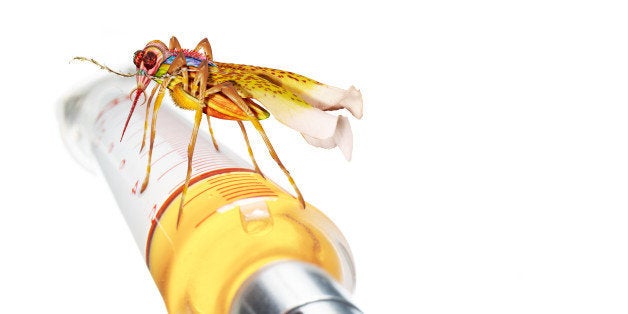
"Parasites everywhere have reason to fear." That is how Michael Gerson opened his Washington Post column last week about Bill Gates' commitment to eradicate malaria. But the statement could have applied to the entire week of the U.N. General Assembly, which marked a turning point in the campaign to end this disease.
Bold goal-setting and sustained global commitment have cut malaria deaths by 60 percent over the past 15 years, and momentum is building to rid the world of this deadly disease once and for all. Last week, that effort shifted into high gear.
In his speech to open the U.N. General Assembly, President Obama called it a "moral outrage" that so many children throughout the world are "just one mosquito bite away from death." He told the world leaders: "It's literally a matter of life and death, and now the world must act."
As if in response, the very next day Bill Gates and Ray Chambers, the U.N. Secretary-General's Special Envoy, issued a report outlining their vision for eradicating malaria within a generation. "Today, we have an opportunity to achieve something that was once thought impossible," the report states. "With the right combination of political will, strategic rigor, technical innovation, and focused investment, we can end malaria forever."
The report, titled From Aspiration to Action, outlines an innovative and enormously ambitious plan to end one of the world's oldest, deadliest diseases by 2040 with new strategies, tools and financing. (Disclosure: Malaria No More worked closely with the authors to develop the report.)
The report was launched at a dinner hosted by Mr. Gates and Mr. Chambers and attended by Presidents Jakaya Kikwete of Tanzania and Ellen Johnson Sirleaf of Liberia, two key drivers of the extraordinary 69 percent decline in child malaria deaths in Africa since 2000; WHO Director General Margaret Chan; business leaders; and key decision makers from the United States, Canada, Ethiopia, United Arab Emirates and Australia. The group toasted the plan and pledged support to help make it a reality.
Influential news outlets from Africa to India to Latin America carried news of the invigorated effort. The New York Times editorial page called on industrialized nations and developing countries to put more money toward eradication. The Economist said that eradicating malaria, "would rank among humanity's greatest achievements."
The report estimates the total cost of malaria eradication at around $110 billion over the next 25 years. But achieving it would produce an estimated $2 trillion in economic benefits and save an additional 11 million lives by 2040. You don't have to be Bill Gates to see the logic to a 20-to-1 return on investment.
The most compelling argument for malaria eradication, however, is that we may not have a choice. We face two kinds of resistance--biological and political--that threaten to reverse hard-won gains and could cost millions of lives if malaria were to resurge.
Earlier this week, the Nobel Prize in Medicine was awarded to Youyou Tu, the Chinese scientist who discovered that Artemisia, derived from the "sweet wormwood" plant, could be used as an effective treatment for malaria. Today, Artemisinin-based therapies are the frontline treatment for malaria, used to treat millions of cases per year.
But the announcement was bittersweet. Even as we celebrate Dr. Tu's groundbreaking discovery, the world faces expanding resistance to Artemisinin in Southeast Asia. We're in a technological arms race to outpace emerging resistance to malaria drugs and insecticides, and the only way to win this race definitively is to eradicate the disease altogether.
A second potential form of resistance, equally alarming, is political. Over the past decade, we've seen the emergence of an unprecedented global coalition committed to reducing the burden of the disease. Led by the United States, United Kingdom, the Global Fund, and endemic country voices, the world has saved more than 6 million lives from malaria and grown funding by 2,000 percent since the year 2000--to roughly $3 billion per annum.
It is an inspiring story of progress, but a fragile one. History has shown that if we don't stay focused on malaria, it can come roaring back. Part of the argument for eradication is that we can't expect the world to keep funding at current levels indefinitely just to maintain the status quo. The great selling point is that malaria is the only disease of this scale that we can conceivably eradicate in our lifetimes. We need that clear, time-bound goal to maintain political support.
The next five years are going to be critical. Now is when we need to deliver the new technologies that make eradication possible. Now is when we must prove innovative strategies and demonstrate that elimination is possible in all three regions where malaria persists--the Americas, Asia and Africa. And now is when we must mobilize new funding sources from international donors, the developed world and even those countries that are being ravaged by this disease, to accelerate progress towards our goal.
I have been working to end malaria for the past eight years, and I have never witnessed a moment quite like this. If we redouble our investments, our innovative thinking and our resolve, we can truly make this the beginning of the end of malaria.